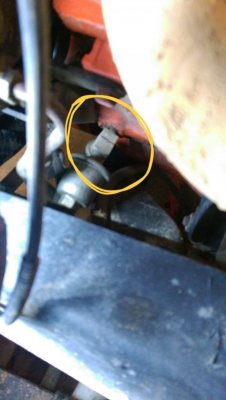chengny
Full Access Member
- Joined
- Feb 22, 2012
- Posts
- 4,084
- Reaction score
- 1,029
- Location
- NH
- First Name
- Jerry
- Truck Year
- 1986
- Truck Model
- K3500
- Engine Size
- 350/5.7
Any gauge is fine - there's no such thing as oil specific pressure gauge. You don't have to order it either.
Home Depot keeps this gauge on the shelf and in stock:
Model # M1002-8B Internet # 203990005
100 psi Pressure Gauge with 1/8 in. Back Connection
It's like $6.
But rather than worrying about where to buy a gauge, can I suggest that you first find out where you can easily tap into the oil system. Find a port that is visible and also allows you to physically get a gauge into it.
I know I initially suggested that you locate the sender - and use that port to install a gauge, but that isn't the only option. And, you don't have to pull the sender if you find an easier place to stab the gauge.
Check out block, in the area above the oil filter. You should notice a series of holes in the casting. I can't provide much insight on 454's so you're on your own this but; I looked around and it seems like 2 of them are oil ports and can be used to install a gauge.
The sizes of the holes is apparently a mystery - even to most of the folks who run these engines. But anyway, your best bet might be to see if you can even pull the plugs from either one - or both - of the two ports.
If you can access either port (or both) that will determine the NPT size of the gauge you buy.
Home Depot keeps this gauge on the shelf and in stock:
You must be registered for see images attach
Model # M1002-8B Internet # 203990005
100 psi Pressure Gauge with 1/8 in. Back Connection
It's like $6.
But rather than worrying about where to buy a gauge, can I suggest that you first find out where you can easily tap into the oil system. Find a port that is visible and also allows you to physically get a gauge into it.
I know I initially suggested that you locate the sender - and use that port to install a gauge, but that isn't the only option. And, you don't have to pull the sender if you find an easier place to stab the gauge.
Check out block, in the area above the oil filter. You should notice a series of holes in the casting. I can't provide much insight on 454's so you're on your own this but; I looked around and it seems like 2 of them are oil ports and can be used to install a gauge.
You must be registered for see images attach
The sizes of the holes is apparently a mystery - even to most of the folks who run these engines. But anyway, your best bet might be to see if you can even pull the plugs from either one - or both - of the two ports.
If you can access either port (or both) that will determine the NPT size of the gauge you buy.


